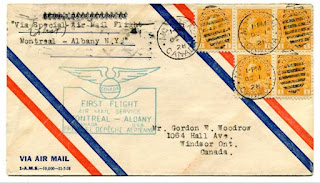The First Air Mail Services. These were provided by small companies flying into remote Northern areas in support of prospectors and miners. The Post Office allowed these companies to charge for the letters carried, and to issue their own stamps. These stamps had a "semi-official" status, as they were sold from post offices, but the post offices did not assume responsibility for delivery of the mail or help with the cost of the service.
Historic flight from Calgary to Edmonton, 9 July 1918.
On 9 July, aided by a compass and a map of Alberta, Katherine Stinson, an exceptional female pilot successfully piloted her Curtiss Special plane from Calgary to Edmonton with a mailbag containing 259 letters. The plane had been custom built using parts from a number of other First World War aircrafts. It was the first time in the West and the second in all of Canada that mail had been transported by air. It was a two-hour flight. The first one was from Montreal to Toronto on 24 June 1918.
First Canadian Government Air Mail Flights. The first of the services funded by the Post Office began in September 1927. It received mail from incoming steamers at Rimouski, where the St Lawrence River pilot boarded ships, and flew it to Montreal in order to speed up mail from Europe to Canada. In October 1927, the Post Office also began paying for airmail services to some remote locations which were often cut off during the winter.
First Flight Covers. In August 1928, the Canadian National Exhibition decided to organize an air show, as part of the celebrations for its 50th Anniversary. The events included special flights carrying mail to and from Toronto. Actually, the 1920's were a time of great interest in everything to do with aviation. It was also a time when stamp collecting was a very popular hobby. On the opening day of the air show flights carried mail from Windsor and Quebec City to Toronto. A fee of 5 cents was charged for each envelope carried compared to the normal cost of 2 cents to send a letter. Over 30,000 pieces of mail were carried on the flights and more than 27,000 on the return flights including the flight from Toronto to Kingston on 29 August 1928.
On 1st October 1928, the Post Office inaugurated an airmail service between Montreal and Albany,
On 28 January 1929, the First Flight mail services, from Ottawa to St John.
The Post Office would send out details of future First Flights to collectors. The flights were also announced in newspapers, and in stamp magazines, that were very popular.
In August 1929, the Post Office announced the inauguration of airmail service along the Mackenzie River from Fort McMurray to Aklavik, north of the Arctic Circle. There would be 12 intermediate stops. Aklavik had grown around Hudson's Bay Company trading post and became the Centre of the region. Though in 1930 its population was only about 400.
The First Flight from Toronto to Calgary, on 1st March,1939.






























































